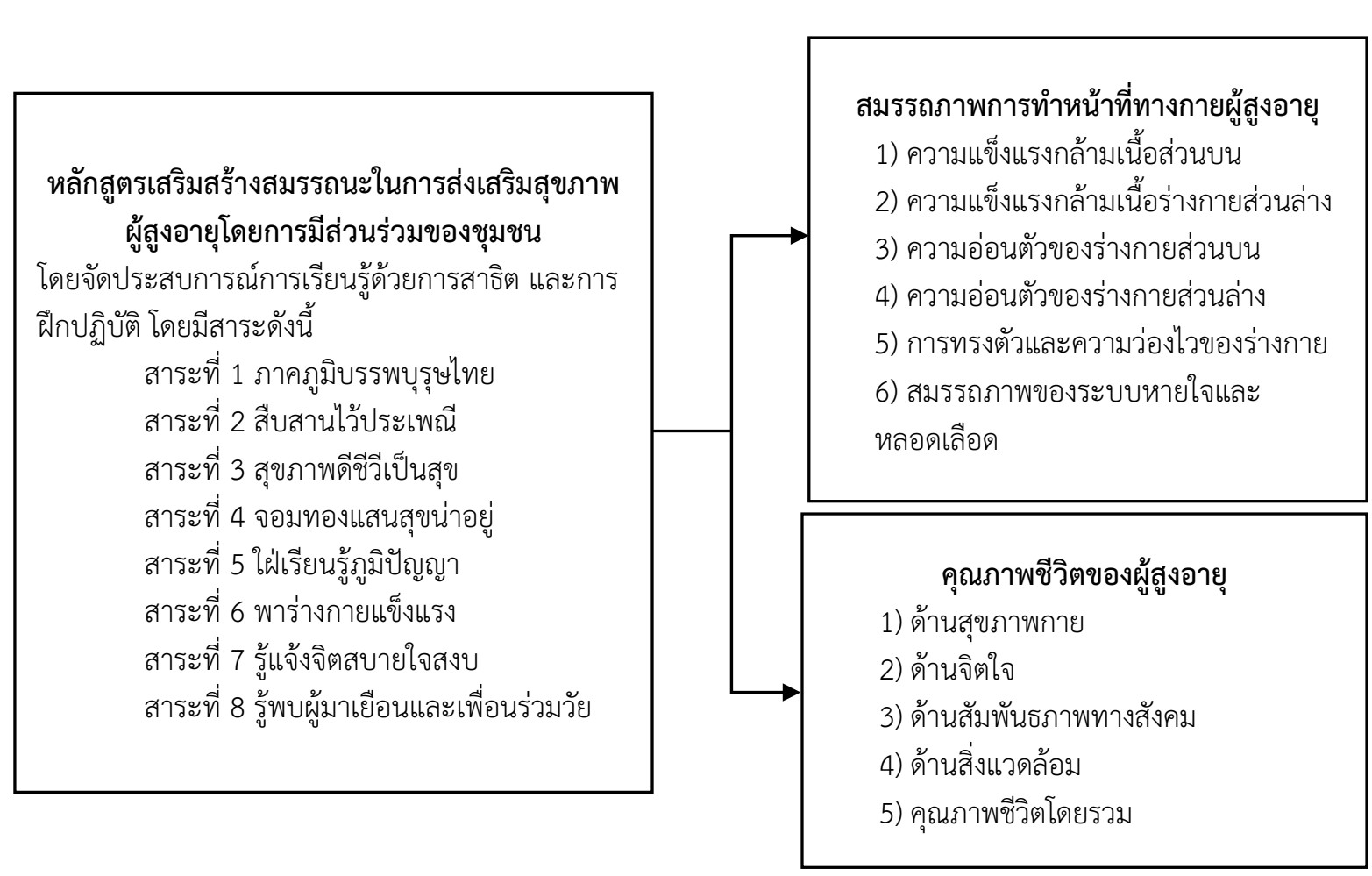Effects of the Curriculum for Enhancing Competencies in Health Promotion of the Elderly by Community Participation on Functional Fitness and Quality of Life
Main Article Content
Abstract
The purpose of this research was to examine effects of the curriculum for enhancing competencies in health promotion of the elderly by community participation on functional fitness and quality of life in Chom Thong Subdistrict, Mueang District, Phitsanulok Province.
This was a quasi-experimental study with one group pretest-posttest design to compare the functional fitness and quality of life of the elderly at baseline and at the end of experiment.
The sample group consisted of 30 purposively selected elderly students who participated in learning experience activities with demonstrations and curriculum exercises for a period of 12 weeks. Data were collected using validated tools, including a personal data record form, a Senior Fitness Test battery, and a Thai version of the brief form of the World Health Organization Quality of Life. The data were analyzed using descriptive statistics and a paired samples t-test. The results showed that at the end of experiment: mean scores of the functional fitness assessments, including diastolic blood pressure, waist circumference, upper and lower body muscle strength, lower body flexibility, balance and agility, and aerobic endurance significantly improved compared to those at baseline (p<0.05); and mean scores of the quality of life assessments on overall and three components, including mental, social, and environmental aspects were significantly higher than those at baseline (p<0.05).
The results indicate that the curriculum can improve health and quality of life of the elderly. Therefore, it should be implemented in a way that is appropriate to the local context and is consistent with the problems, and that truly meets the needs of the elderly.
Article Details
References
กรมการปกครอง สำนักบริหารทะเบียน. (2566). สถิติประชากรทางการทะเบียนราษฎร. สืบค้น 23 กันยายน2566, จาก https://stat.bora.dopa.go.th/stat/statnew/statMONTH/statmonth/#/ display Data)
กระทรวงสาธารณสุข. (2566). รายงานสุขภาพสาเหตุการป่วยตาย. สืบค้น 23 กันยายน 2566, จาก https://hdcservice.moph.go.th/hdc/reports/page.php?cat_id=491672679818600345dc1833920051b2
เจิมศักดิ์ ปิ่นทอง. (2558). การปฏิรูประบบรองรับสังคมสูงวัย. กรุงเทพฯ: โอเดียนสโตร์.
ชัยยา นรเดชานันท์, ณัทกวี ศิริรัตน์ และเพชรีย์ กุณาละสิริ. (2564). การพัฒนาหลักสูตรเสริมสร้างสมรรถนะผู้สูงอายุในการส่งเสริมสุขภาพและป้องกันภาวะแทรกซ้อนจากโรคไม่ติดต่อเรื้อรัง. วารสารทหารบก. 22(1). 390-401
นริสา วงศ์พนารักษ์ และสายสมร เฉลยกิตติ. (2557). คุณภาพชีวิต : การศึกษาในผู้สูงอายุไทย. วารสารพยาบาลทหารบก, 15(3), 64-70.
บุญใจ ศรีสถิตนรากูร. (2553). ระเบียบวิธีวิจัยทางการพยาบาล (พิมพ์ครั้งที่ 5). ยูแอนด์ไอ อินเตอร์มีเดีย.
มูลนิธิสถาบันวิจัยและพัฒนาผู้สูงอายุไทย (มส.ผส.). (2565). สถานการณ์ผู้สูงอายุไทย พ.ศ. 2564. นครปฐม:สถาบันวิจัยประชากรและสังคม มหาวิทยาลัยมหิดล.
ยุพิน ทรัพย์แก้ว. (2559). การพัฒนาคุณภาพชีวิตผู้สูงอายุด้วยหลักสูตรโรงเรียนผู้สูงอายุของศูนย์ความเป็นเลิศด้านการสร้างเสริมสุขภาพผู้สูงอายุ วิทยาลัยพยาบาลบรมราชชนนีนครศรีธรรมราช. วารสารการพยาบาลและการศึกษา. 9(2), 25-39.
ศศิพัฒน์ ยอดเพชร, ภาวนา พัฒนศรี และธนิกานต์ ศักดาพร. (2560). การถอดบทเรียนตัวอย่างที่ดีของโรงเรียนและชมรมผู้สูงอายุที่มีกิจกรรมถ่ายทอดความรู้. กรุงเทพฯ: เจพริ้นท์.
สำนักงานสถิติแห่งชาติ. (2564). รายงานการสำรวจประชากรผู้สูงอายุในประเทศไทย พ.ศ. 2563. สำนักงานสถิติแห่งชาติ.
สำนักงานสาธารณสุขจังหวัดพิษณุโลก. (2564). รายงานประจำปี 2564. สืบค้น 23 กันยายน 2566, จาก https://cloud.plkhealth.go.th/index.php/s/Eo2Tb6D6tESw7CN#pdfviewer
สุวัฒน์ มหัตนิรันดร์กุล, วิระวรรณ ตันติพิวัฒนสกุล และวนิดา พุ่มไพศาลชัย. (2545). แบบคัดกรองทางสุขภาพจิต: เครื่องชี้วัดคุณภาพชีวิตขององค์การอนามัยโลกชุดย่อ ฉบับภาษาไทย. โครงการจัดทำโปรแกรมสำเร็จรูปในการสำรวจสุขภาพจิตในพื้นที่ ปี พ.ศ.2545. นนทบุรี: กรมสุขภาพจิต.
อัมรา ธำรงทรัพย์, ปิยมณฑ์ พฤกษชาติ และเตือนใจ ศรีประทุม. (2561). ผลของรูปแบบการจัดกิจกรรมสร้างเสริมสมรรถภาพการทำหน้าที่ทางกายสำหรับผู้สูงอายุกลุ่มติดสังคม. วารสารสำนักงานป้องกันควบคุมโรคที่ 7 ขอนแก่น. 25(3), 42-55.
Bandura, A. (1980). Gauging the relationship between self-efficacy judgment and action. Cognitive Therapy and Research. 4, 263-268.
Cohen, J. (1992). A power primer. Psychological Bulletin, 112(1), 155-159.
Kim, S., Lee, E. J., & Kim, H. O. (2021). Effects of a Physical Exercise Program on Physiological, Psychological, and Physical Function of Older Adults in Rural Areas. International journal of environmental research and public health, 18(16), 8487. https://doi.org/10.3390/ ijerph18168487
Rikli, R.E., & Jones, C.J. (1999). Development and validation of a functional fitness test for community-residing older adults. Journal of Aging and Physical Activity, 7(2), 129–61.
Rondón García, L. M., & Ramírez Navarrro, J. M. (2018). The Impact of Quality of Life on the Health of Older People from a Multidimensional Perspective. Journal of aging research, 2018, 4086294. https://doi.org/10.1155/2018/4086294


